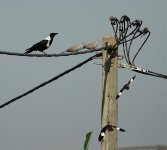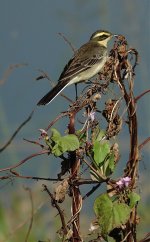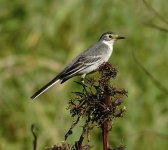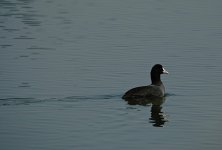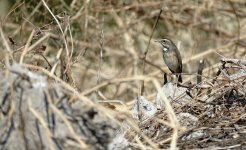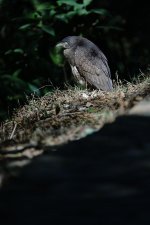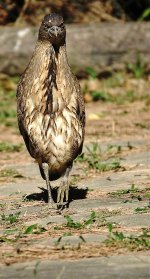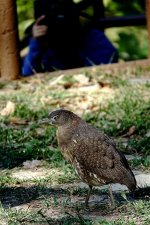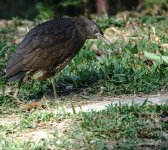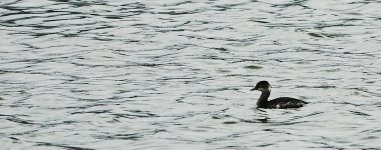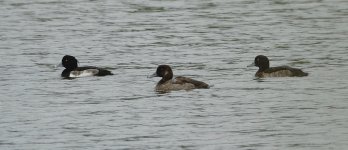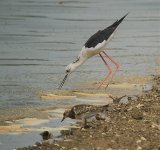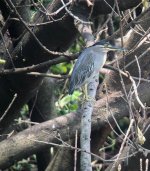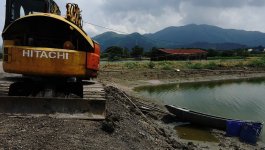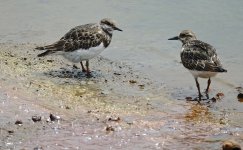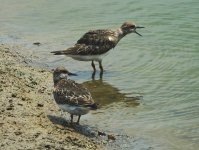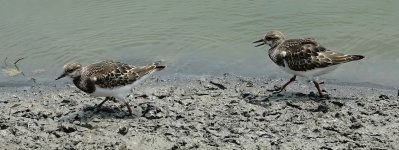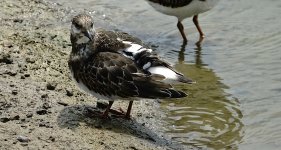Fantastic day again. I would love to come and bird your patch with you right now Mike! As you know, I had a similar sized (30 acre) patch in Dalian (also fish ponds) some years ago now and I can certainly feel your excitement when you find something like a Eurasian Jay in your area. When you bird one site over and over, you really get a sense of migration and trends. Sounds like mid-November is the time to be there. Great reading again and here's to a Swinhoes Rail!
-
Welcome to BirdForum, the internet's largest birding community with thousands of members from all over the world. The forums are dedicated to wild birds, birding, binoculars and equipment and all that goes with it.
Please register for an account to take part in the discussions in the forum, post your pictures in the gallery and more.
You are using an out of date browser. It may not display this or other websites correctly.
You should upgrade or use an alternative browser.
You should upgrade or use an alternative browser.
San Tin Fishponds (and beyond), Hong Kong (1 Viewer)
- Thread starter MKinHK
- Start date
More options
Who Replied?MKinHK
Mike Kilburn

Tom its been excellent again this autumn. Please let me know if you're ever heading this way.
I'm supposed to be out at San Tin today, but a nasty stomach bug knocked my over yesterday and I'm grounded today to fully recover. This is a bummer because I took a day off yesterday and went back to San Tin in pursuit of the elusive ton, and would have loved to be doing the same today. Oh well, at least this gives me the chance to do a timely write-up.
I started birding around 0800, giving little extra time to the approach road, hoping to pick up some of the village birds that don't appear in the fishponds. There were lots of Yellow-Browed Warblers, Cinereous Tit and Masked Laughingthrushes, plus Common Tailorbird, a couple of Daurian Redstarts, Chinese and Crested Bulbuls and a party of three or four Chinese Blackbirds and a flyover Grey Wagtail. More interesting were three or four Chestnut Bulbuls - these are generally forest birds, but migrant flocks drop down all over the place - and a confiding pair of Manchurian Bush Warblers. I had frustratingly brief views of a calling pair of Grey-backed Thrushes, but also picked up an Olive-backed Pipit, a species which seems to have declined in the last couple of years.
Entering the fishponds I was pleased that a couple of Whiskered Terns were hanging on and even more to discover that the reason for the Crested and Common Mynas and Black-necked Starlings to go nuts was the Black-shouldered Kits drifting over their "shouting trees", and a handsome Collared Crow added his voice from an overhead wire.
The Citrine Wagtail was in the same corner of its pond with the usual crowd of taivana Eastern Yellow Wagtails and Amur Wagtails. It seems to be showing a bit more yellow on the face, and I'm hoping it will stay through the winter and show us its full glory. I took some time to confirm a larger accro was indeed an Oriental Reed Warbler. I saw one other and just a couple of Black-browed Reed Warblers on a day when passage of Dusky Warblers also seemed to be down. I was pleased to pick up a couple of Chinese Penduline Tits next to the one where a Black-necked Grebe - rare here in HK - had been seen on Tuesday, and had fly-by views of the Common Starlings a bit later in a flock of Silky Starlings coming to the bread pile next to the speedboat.
Chris had alerted me to a path that provided a view over a couple of ponds on the north side of the reserve. This held a roosting flock of Black-faced Spoonbills, plus a single Eurasian Spoonbill, and a few hundred Common Teals, with a few Wigeons and Shovelers, but none of the extra goodies present on Sunday. As I came out the Greater Spotted Eagle drifted overhead and my first Osprey of the autumn followed suit a few minutes later. I was pleased to pick up the first of two Eurasian Coot next to the Reed Warbler bund, and delighted to get some shots of a smart winter-plumaged Bluethroat a little further along. Then followed a frustrating period when I flushed and failed to get views of a couple of buntings that looked very yellow underneath, but did not quite fit for anything. Based on one hopeless long range shot I suspect at least one was Chestnut Bunting, but another showing a very yellow rump remains a perplexing mystery. I did eventually pick up a female Black-faced Bunting, after also flushing a large heavyset brown warbler that had me fantasizing about Gray's Grasshopper Warbler! A flyover Black-headed Gull - my first of the winter - provided a small measure of compensation.
More to come . . .
Cheers
Mike
I'm supposed to be out at San Tin today, but a nasty stomach bug knocked my over yesterday and I'm grounded today to fully recover. This is a bummer because I took a day off yesterday and went back to San Tin in pursuit of the elusive ton, and would have loved to be doing the same today. Oh well, at least this gives me the chance to do a timely write-up.
I started birding around 0800, giving little extra time to the approach road, hoping to pick up some of the village birds that don't appear in the fishponds. There were lots of Yellow-Browed Warblers, Cinereous Tit and Masked Laughingthrushes, plus Common Tailorbird, a couple of Daurian Redstarts, Chinese and Crested Bulbuls and a party of three or four Chinese Blackbirds and a flyover Grey Wagtail. More interesting were three or four Chestnut Bulbuls - these are generally forest birds, but migrant flocks drop down all over the place - and a confiding pair of Manchurian Bush Warblers. I had frustratingly brief views of a calling pair of Grey-backed Thrushes, but also picked up an Olive-backed Pipit, a species which seems to have declined in the last couple of years.
Entering the fishponds I was pleased that a couple of Whiskered Terns were hanging on and even more to discover that the reason for the Crested and Common Mynas and Black-necked Starlings to go nuts was the Black-shouldered Kits drifting over their "shouting trees", and a handsome Collared Crow added his voice from an overhead wire.
The Citrine Wagtail was in the same corner of its pond with the usual crowd of taivana Eastern Yellow Wagtails and Amur Wagtails. It seems to be showing a bit more yellow on the face, and I'm hoping it will stay through the winter and show us its full glory. I took some time to confirm a larger accro was indeed an Oriental Reed Warbler. I saw one other and just a couple of Black-browed Reed Warblers on a day when passage of Dusky Warblers also seemed to be down. I was pleased to pick up a couple of Chinese Penduline Tits next to the one where a Black-necked Grebe - rare here in HK - had been seen on Tuesday, and had fly-by views of the Common Starlings a bit later in a flock of Silky Starlings coming to the bread pile next to the speedboat.
Chris had alerted me to a path that provided a view over a couple of ponds on the north side of the reserve. This held a roosting flock of Black-faced Spoonbills, plus a single Eurasian Spoonbill, and a few hundred Common Teals, with a few Wigeons and Shovelers, but none of the extra goodies present on Sunday. As I came out the Greater Spotted Eagle drifted overhead and my first Osprey of the autumn followed suit a few minutes later. I was pleased to pick up the first of two Eurasian Coot next to the Reed Warbler bund, and delighted to get some shots of a smart winter-plumaged Bluethroat a little further along. Then followed a frustrating period when I flushed and failed to get views of a couple of buntings that looked very yellow underneath, but did not quite fit for anything. Based on one hopeless long range shot I suspect at least one was Chestnut Bunting, but another showing a very yellow rump remains a perplexing mystery. I did eventually pick up a female Black-faced Bunting, after also flushing a large heavyset brown warbler that had me fantasizing about Gray's Grasshopper Warbler! A flyover Black-headed Gull - my first of the winter - provided a small measure of compensation.
More to come . . .
Cheers
Mike
Attachments
MKinHK
Mike Kilburn

Lots of extra walking to the NE corner delivered Red and Oriental Turtle Doves and White-cheeked Starling in the trees on the southern edge of the reserve and I made a recording of a briefly seen Bush Warbler that was too skulky for me to see much more than an eyering, a super and a yellow lower mandible. I eventually tracked down a couple of Little Ringed Plovers here after being surprised not to find them elsewhere on the site.
The Great Crested Grebe was still in with the Tufties, as was a Common Pochard that refused to lift its head while swimming away with the Tufties, and I was pleased to confirm with the camera that the distant flight of ducks were indeed Northern Pintails. The male Eurasian Kestrel helpful drifted right over and I flushed one of the two Common Buzzards from the trees along the edge of the site. My last hurrah was an overgrown lots close to the main drainage channel (which held a leg-flagged Marsh Sandpiper - with letters JO on both flags) which produced a couple of Little Buntings, a male Black-faced Bunting and, as a fine finale, a lovely male Siberian Rubythroat that pished up and posed beautifully.
I managed a new record of 97 species on what seemed like a solid, but not spectacular day, but since Chris had managed an outstanding 106 on Tuesday it still felt like I was playing catch up. Maybe tomorrow!
Cheers
Mike
The Great Crested Grebe was still in with the Tufties, as was a Common Pochard that refused to lift its head while swimming away with the Tufties, and I was pleased to confirm with the camera that the distant flight of ducks were indeed Northern Pintails. The male Eurasian Kestrel helpful drifted right over and I flushed one of the two Common Buzzards from the trees along the edge of the site. My last hurrah was an overgrown lots close to the main drainage channel (which held a leg-flagged Marsh Sandpiper - with letters JO on both flags) which produced a couple of Little Buntings, a male Black-faced Bunting and, as a fine finale, a lovely male Siberian Rubythroat that pished up and posed beautifully.
I managed a new record of 97 species on what seemed like a solid, but not spectacular day, but since Chris had managed an outstanding 106 on Tuesday it still felt like I was playing catch up. Maybe tomorrow!
Cheers
Mike
Attachments
-
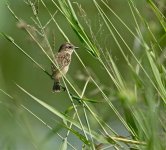 DSC00118 Stejneger's Stonechat @ San Tin.jpg162.3 KB · Views: 17
DSC00118 Stejneger's Stonechat @ San Tin.jpg162.3 KB · Views: 17 -
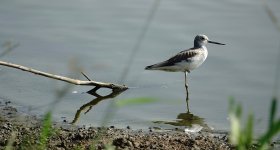 DSC00130 Common Greenshank @ San Tin.jpg1.1 MB · Views: 21
DSC00130 Common Greenshank @ San Tin.jpg1.1 MB · Views: 21 -
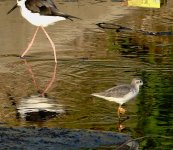 DSC00151 Marsh Sandpiper @ San Tin.jpg1.6 MB · Views: 28
DSC00151 Marsh Sandpiper @ San Tin.jpg1.6 MB · Views: 28 -
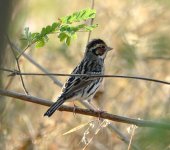 DSC00147 Little Bunting @ San Tin.jpg1 MB · Views: 15
DSC00147 Little Bunting @ San Tin.jpg1 MB · Views: 15 -
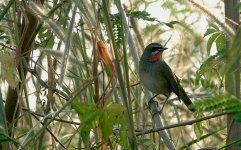 DSC00145 Siberian Rubythroat @ San Tin.jpg1.4 MB · Views: 19
DSC00145 Siberian Rubythroat @ San Tin.jpg1.4 MB · Views: 19
How common is it for you to find flagged waders Mike? I have an old chart from 2010 that says yellow over orange in East Asia is from SW WA Australia. I have a word document from 2011 saying the same thing but that there could possibly be a white ring/band lower on the left leg as well?
Owen Krout
Well-known member

I was curious also, Mike. Do you happen to know of how to report any bands spotted in this part of the world? I photographed a flagged Canada Goose while I was in the US and it was easy to find the online site to report them there. Even got a nice reply giving me the information they had on the bird.
Hi Owen and Mike, I have some information from 2010 about how to report flags, rings, bands, etc... I did this many times before and always had great feedback with lots of information about the bird's history. I'm happy to post that here but I'll wait for Mike to see if he has something more up to date.
MKinHK
Mike Kilburn

Hi Tom
Have nothing on flag reporting - I just put mine on the HKBWS website.This post is not about San Tin. Bt it does continue the years fine series of twitches further afield in pursuit of good birds. A few years ago (2014) I missed seeing one of the most wanted vagrants in Hong Kong - Japanese Night Heron, and the first for 20-odd years - through a combination of suppression and illness. This made me pretty grumpy!
The next one to turn up appeared ironically when I was in Japan celebrating my birthday at the tail end of November, and I thought I'd dipped again. Thankfully the bird, which at the time of writing continues to be incredibly tame as it hunts worms, and on one occasion a stick insect at a public picnic site at the entrance of San Kung Country Park, showed so well that the photographers were having to retreat to get the bird in the frame as it walked steadily towards them!
My first view was of the bird standing in a ray of sunlight surrounded by shadow on a path above the picnic site, which gave much more of a sense of this bird of an elusive stalker of the forest edge, before it dropped down and wandered about within a couple of metres of the firing squad.
It's all a bit strange that a bird which has been basically out of reach for quarter of a century becomes perhaps the easiest to see and photograph of any mega rarity I've ever seen!
Have nothing on flag reporting - I just put mine on the HKBWS website.This post is not about San Tin. Bt it does continue the years fine series of twitches further afield in pursuit of good birds. A few years ago (2014) I missed seeing one of the most wanted vagrants in Hong Kong - Japanese Night Heron, and the first for 20-odd years - through a combination of suppression and illness. This made me pretty grumpy!
The next one to turn up appeared ironically when I was in Japan celebrating my birthday at the tail end of November, and I thought I'd dipped again. Thankfully the bird, which at the time of writing continues to be incredibly tame as it hunts worms, and on one occasion a stick insect at a public picnic site at the entrance of San Kung Country Park, showed so well that the photographers were having to retreat to get the bird in the frame as it walked steadily towards them!
My first view was of the bird standing in a ray of sunlight surrounded by shadow on a path above the picnic site, which gave much more of a sense of this bird of an elusive stalker of the forest edge, before it dropped down and wandered about within a couple of metres of the firing squad.
It's all a bit strange that a bird which has been basically out of reach for quarter of a century becomes perhaps the easiest to see and photograph of any mega rarity I've ever seen!
Attachments
Great photos of a great specie Mike. As you say, it's strange how rarities can be so visible and calm sometimes.
Regarding the reporting of flags/rings, this is what I have from 2010 and 2011. Not sure how current it all is.
Regarding the reporting of flags/rings, this is what I have from 2010 and 2011. Not sure how current it all is.
Attachments
johnallcock
Well-known member
Just seen this thread and the discussion on leg flags.
Mike's Marsh Sandpiper has the combination white over yellow, indicating it was flagged in Hong Kong (note that the flags often get a bit stained as on this bird). I may have some information at home on J0 but it won't be up to date.
It's not particularly unusual to see HK flagged birds here (although mostly at Mai Po rather than around the ponds) and birds from elsewhere often turn up on migration, especially from Australia.
Hong Kong birds can be reported to the HKBWS - the easiest way is via their discussion forum at http://www.hkbws.org.hk/BBS/viewthread.php?tid=28176&extra=page=1&page=14
Other leg flags on the East Asian Australasian Flyway are best reported to the Australian Wader Studies Group at: [email protected]
Mike's Marsh Sandpiper has the combination white over yellow, indicating it was flagged in Hong Kong (note that the flags often get a bit stained as on this bird). I may have some information at home on J0 but it won't be up to date.
It's not particularly unusual to see HK flagged birds here (although mostly at Mai Po rather than around the ponds) and birds from elsewhere often turn up on migration, especially from Australia.
Hong Kong birds can be reported to the HKBWS - the easiest way is via their discussion forum at http://www.hkbws.org.hk/BBS/viewthread.php?tid=28176&extra=page=1&page=14
Other leg flags on the East Asian Australasian Flyway are best reported to the Australian Wader Studies Group at: [email protected]
MKinHK
Mike Kilburn

Last Sunday I had the pleasure of showing San Tin to BF legend Jos Stratford, who was passing through Hong Kong on his way down under. I am happy to report that were no earthquakes, wolf attacks, gun battles, or other inconveniences, and even Hong Kong's protestors failed to disrupt us.
Following Chris Campion's advice we started in the small park across the road from San Tin football pitch, which held a rare Deep Bay Scarlet Minivet, Pallas's Leaf Warbler and a few Olive-backed Pipits. Going through the village we added Grey and Amur Wagtails on the sewagey stream and just my second San Tin Fork-tailed Sunbird - a female - in the trees on the back of the flood relief pond. A Black-faced Bunting also showed briefly and a small group of Azure-winged Magpies were foraged helpfully in the middle of the access road.
A pair of Collared Crows and three Common Starlings added to the usual birds along the first ponds and I was chuffed to see my first patch Greater Painted-snipe - a nicely marked male - when it flushed from the grassy edge of a pond that also held good numbers of the usual waders (Wood, Green Common and Marsh Sandpipers, Greenshank and Spotted Redshank, Black-winged Stilt and Avocet, LRP Common Snipe) as many Zitting Cisticolas as I've ever seen here a few each of Common Teal and Shoveler, and a mixed jumble of Barn and Red-rumped Swallows plus a single Sand Martin.
Flyover Greater Spotted and Eastern Imperial Eagles were the only supplements to the usual Black Kites until a couple of late Eurasian Kestrels added a modicum of respectability to the raptor list, although a flyby from three Black-faced Spoonbills and a slightly larger Eurasian Spoonbill, and the usual flocks of Silky Starlingsand Crested Mynas added to the overall birdiness.
The pond bunds held Spotted Doves, Black-collared Starlings, Eastern Yellow Wagtails and Stejneger's Stonechats around the various noxious piles of fish food, while Grey and Chinese Pond Herons, White-breasted Waterhen and the usual egrets, including a solitary Intermediate Egret stalked the shallows or lurked in the grassy fringes.
A long loop up to the western fringes of the nature reserve paid dividends in the shape of a Greater Coucal gliding across a pond, White-cheeked Starlings, Red and Oriental Turtle Doves three or four typically noisy Pied Kingfishers, skulking Wryneck, Manchurian Bush Warbler and Oriental Reed Warblers, three or four more furtive Siberian Rubythroats. A dozen Tufted Ducks landing on the wallet pond held a rather scruffy Greater Scaup, and the Black-necked Grebe whose admirers included one duckwit who angered a fishpond operator by getting into the water, had caused access for birders to be banned from San Tin.
Other bits and pieces included my first Northern Skylarks for a couple of years, both thanks to Jos, found as we added a Bluethroat, Richard's Pipit and a few Red-throated Pipits along the scruffier bunds. We could not find the Ferruginous Duck among the regular Tufties, although there were now four Common Pochards and the long-staying Great Crested Grebe.
The last birds we added were a showy group of Red-billed Blue Magpies and some shyer Masked Laughingthrushes along the Main Drainage Channel, and we finished an enjoyable session with a solid 95 species.
Cheers
Mike
Following Chris Campion's advice we started in the small park across the road from San Tin football pitch, which held a rare Deep Bay Scarlet Minivet, Pallas's Leaf Warbler and a few Olive-backed Pipits. Going through the village we added Grey and Amur Wagtails on the sewagey stream and just my second San Tin Fork-tailed Sunbird - a female - in the trees on the back of the flood relief pond. A Black-faced Bunting also showed briefly and a small group of Azure-winged Magpies were foraged helpfully in the middle of the access road.
A pair of Collared Crows and three Common Starlings added to the usual birds along the first ponds and I was chuffed to see my first patch Greater Painted-snipe - a nicely marked male - when it flushed from the grassy edge of a pond that also held good numbers of the usual waders (Wood, Green Common and Marsh Sandpipers, Greenshank and Spotted Redshank, Black-winged Stilt and Avocet, LRP Common Snipe) as many Zitting Cisticolas as I've ever seen here a few each of Common Teal and Shoveler, and a mixed jumble of Barn and Red-rumped Swallows plus a single Sand Martin.
Flyover Greater Spotted and Eastern Imperial Eagles were the only supplements to the usual Black Kites until a couple of late Eurasian Kestrels added a modicum of respectability to the raptor list, although a flyby from three Black-faced Spoonbills and a slightly larger Eurasian Spoonbill, and the usual flocks of Silky Starlingsand Crested Mynas added to the overall birdiness.
The pond bunds held Spotted Doves, Black-collared Starlings, Eastern Yellow Wagtails and Stejneger's Stonechats around the various noxious piles of fish food, while Grey and Chinese Pond Herons, White-breasted Waterhen and the usual egrets, including a solitary Intermediate Egret stalked the shallows or lurked in the grassy fringes.
A long loop up to the western fringes of the nature reserve paid dividends in the shape of a Greater Coucal gliding across a pond, White-cheeked Starlings, Red and Oriental Turtle Doves three or four typically noisy Pied Kingfishers, skulking Wryneck, Manchurian Bush Warbler and Oriental Reed Warblers, three or four more furtive Siberian Rubythroats. A dozen Tufted Ducks landing on the wallet pond held a rather scruffy Greater Scaup, and the Black-necked Grebe whose admirers included one duckwit who angered a fishpond operator by getting into the water, had caused access for birders to be banned from San Tin.
Other bits and pieces included my first Northern Skylarks for a couple of years, both thanks to Jos, found as we added a Bluethroat, Richard's Pipit and a few Red-throated Pipits along the scruffier bunds. We could not find the Ferruginous Duck among the regular Tufties, although there were now four Common Pochards and the long-staying Great Crested Grebe.
The last birds we added were a showy group of Red-billed Blue Magpies and some shyer Masked Laughingthrushes along the Main Drainage Channel, and we finished an enjoyable session with a solid 95 species.
Cheers
Mike
Attachments
Last edited:

And thoroughly enjoyable it was, many thanks are due. Did like that Paintied Snipe especially.
Have to report that one week on, bar a (very pleasant) stranding an extra night on a small island due to winds, I have still yet to experience any earthquakes, wars or other mishaps of various means
May start the report soon...
Have to report that one week on, bar a (very pleasant) stranding an extra night on a small island due to winds, I have still yet to experience any earthquakes, wars or other mishaps of various means
May start the report soon...
MKinHK
Mike Kilburn

My first return to San Tin for nearly nine months in the heat of early September delivered a nice suite of migrants, but not without some hard work!
While it wasn't exactly heaving I enjoyed the welcome from a scruffy eagle of Cattle Egrets and juvenile, doubtless locally-fledged juvenile Chinese Pond Herons, with a spread of 20 or so Common Sandpipers across the site providing the most visible evidence of migration being underway.
With no obvious drained pond waders had to be winkled out wherever there was a bit of dry pond edge. Black-winged Stilts were the most abundant - and of course the most visible, but the third water of the day a juvenile Ruddy Turnstone was absolutely not expected. Looking incredibly scruffy and dowdy next to a pair of adult Black-winged Stilts that were picking food from the noxious sludge of stale bread that fishpond fish get fed on here I was nonetheless delighted I believe it's a patch first. I was also pleased to watch it flipping bits of sacking on the shore and later that day to capture the short, slightly upturned bill that is specially designed for such levering.
Passerine migrants included two chunky Oriental Reed Warblers, a dozen Eastern Yellow Wagtails and a typically flushed Pallas's Grasshopper Warbler with a fine streaky rufous rump. I picked up the latter on a bund that held lots of acros and PGWs last autumn, and I was surprised that Black-browed Reed Warblers were yet to arrive. Walking around the grass-fringed ponds in the NW corner produced two Yellow Bitterns and a Striated Heron, plus a trio of Oriental Turtle Doves, which breed nearby in very small numbers.
As I headed back I finally found a few more waders on the bare edges of filled ponds. These included singleton Common Redshank, Common Greenshank, and a Long-toed Stint, a couple of each of Wood and Green Sandpipers, three or four LRPs and in a seeping maggot-infested corner hard under a massive Hitachi excavator, a second juvenile Ruddy Turnstone had found my first one from earlier that morning. As I watched them washing and preening a Fantail Snipe tumbled onto the same corner of the fishpond, bringing the wader total to ten, and the day count to somewhere a little north of 50 species.
Cheers
Mike
While it wasn't exactly heaving I enjoyed the welcome from a scruffy eagle of Cattle Egrets and juvenile, doubtless locally-fledged juvenile Chinese Pond Herons, with a spread of 20 or so Common Sandpipers across the site providing the most visible evidence of migration being underway.
With no obvious drained pond waders had to be winkled out wherever there was a bit of dry pond edge. Black-winged Stilts were the most abundant - and of course the most visible, but the third water of the day a juvenile Ruddy Turnstone was absolutely not expected. Looking incredibly scruffy and dowdy next to a pair of adult Black-winged Stilts that were picking food from the noxious sludge of stale bread that fishpond fish get fed on here I was nonetheless delighted I believe it's a patch first. I was also pleased to watch it flipping bits of sacking on the shore and later that day to capture the short, slightly upturned bill that is specially designed for such levering.
Passerine migrants included two chunky Oriental Reed Warblers, a dozen Eastern Yellow Wagtails and a typically flushed Pallas's Grasshopper Warbler with a fine streaky rufous rump. I picked up the latter on a bund that held lots of acros and PGWs last autumn, and I was surprised that Black-browed Reed Warblers were yet to arrive. Walking around the grass-fringed ponds in the NW corner produced two Yellow Bitterns and a Striated Heron, plus a trio of Oriental Turtle Doves, which breed nearby in very small numbers.
As I headed back I finally found a few more waders on the bare edges of filled ponds. These included singleton Common Redshank, Common Greenshank, and a Long-toed Stint, a couple of each of Wood and Green Sandpipers, three or four LRPs and in a seeping maggot-infested corner hard under a massive Hitachi excavator, a second juvenile Ruddy Turnstone had found my first one from earlier that morning. As I watched them washing and preening a Fantail Snipe tumbled onto the same corner of the fishpond, bringing the wader total to ten, and the day count to somewhere a little north of 50 species.
Cheers
Mike
Attachments
Last edited:

Excellent stuff, good birds again. Guess I won't be making a day trip this year ...how the world has changed!
"watch it flipping bits of sacking on the shore and later that day to capture the short, slightly upturned bill that is specially designed for such levering." Haha - not usually on sacking, but yes, designed for levering! Great to have good views of a patch tick.
Fun to read about your finds, and especially like the turnstone and stilt looking to be making parallel movements.
Fun to read about your finds, and especially like the turnstone and stilt looking to be making parallel movements.
Owen Krout
Well-known member

Alas, Jos, it looks like, once again, I will have to forego my longed for winter trip to HK, . . . or Thailand . . . or Vietnam . . . or even Costa Rica! Even Hawaii is problematic!
Great to at least imagine through your reports, Mike.
Great to at least imagine through your reports, Mike.
MKinHK
Mike Kilburn

A baking hot morning with the specific intention of catching the peak week of Manchurian Reed Warbler passage started excellently with a smoky-brown Himalayan Swiftlet that lingered onsite long enough for my failure at photographing birds in flight to drive me to distraction. These silent wisps - I've only seen two others in the last 25+ years of birding here - generally rocket past at high speed. This one was foraging above a fishpond that had attracted a dozen Barn Swallows in company with a House Swift and from time to time came low enough to allow decent shots - at least for someone with more competence.
I was nonetheless delighted with a second patch tick in seven days after Sunday's Ruddy Turnstones, one of which had obviously decided that the attraction of decomposing maggoty fish and whatever feeds off stale soggy bread made for a palatable range of dining options. UK birders of my generation are familiar with the disgusting eating habits of Turnstones, which famously include discarded condoms, so I guess this one was not really pushing the boundaries. I managed one fewer species of wader, failing to find Common Redshank or Long-toed Stint, but in compensation I did fluke a flyover Pied Avocet, while the number of Common Sandpipers had if anything increased.
The second major highlight was finding my third and almost certainly fourth Manchurian Reed Warbler on the patch. An enjoyably circuitous route (a paper on the diet of Brown Wood Owl in Hong Kong that referenced a paper I wrote on BWO's status in Hong Kong (p 210) that was in the same issue of the Hong Kong Bird Report as an article about passage/ trapping dates for reed and bush warblers(p 234) revealed that the first week of September was a great time to be looking for Manchurian Reed Warbler, because they are peaking, while the somewhat similar and far more abundant Black-browed Reed Warbler is yet to arrive. An even more hopeless pic, but there are better shots of last year's bird here and here.
As I reached one of the less actively managed ponds a gingery acro flipped up and very helpfully perched on the top of a reed stem, giving me a nice clear view of the meagre black shadow (rather than the broad bold stripe of Black-browed) above a broad white supercilium and the long-ish tailed short-winged jizz all help to identify it as Manchurian Reed Warbler. While it did call it only gave a very soft contact call rather than the nasal buzz of Manchurian or the harder rattle of Black-browed. I was disappointed that my camera setting had changed and I could not get it to focus on the bird, which disappeared as I fumbled into manual focus, so the single shot below was the best I could manage. After looking at me a couple of times It crossed the corner of the pond and popped up in scope view, but again not for long enough for me to get on it. However I was surprised to see a second gingery butt flip up and over it giving the same contact call before disappearing into the grass, never to be seen again.
The same pond also held a tawny-striped juvenile Yellow Bittern and looks like it has the potential for a lurking Pheasant-tailed Jacana or Watercock as the season progresses. I was actually surprised not to see Oriental Reed Warbler here and only had one all morning. The general area continued to hold a dozen or so Eastern Yellow Wagtails and a Pallas's Grasshopper Warbler came up from the edge of the next pond and flew a short way down the track in front of me.
By this stage the heat was getting to me, my water was gone and I headed straight back for the shade along the access road, where a family party of Azure-winged Magpies giggled above me as I put away the scope and camera and headed into San Tin village in search of a very long, very cool drink.
Cheers
Mike
I was nonetheless delighted with a second patch tick in seven days after Sunday's Ruddy Turnstones, one of which had obviously decided that the attraction of decomposing maggoty fish and whatever feeds off stale soggy bread made for a palatable range of dining options. UK birders of my generation are familiar with the disgusting eating habits of Turnstones, which famously include discarded condoms, so I guess this one was not really pushing the boundaries. I managed one fewer species of wader, failing to find Common Redshank or Long-toed Stint, but in compensation I did fluke a flyover Pied Avocet, while the number of Common Sandpipers had if anything increased.
The second major highlight was finding my third and almost certainly fourth Manchurian Reed Warbler on the patch. An enjoyably circuitous route (a paper on the diet of Brown Wood Owl in Hong Kong that referenced a paper I wrote on BWO's status in Hong Kong (p 210) that was in the same issue of the Hong Kong Bird Report as an article about passage/ trapping dates for reed and bush warblers(p 234) revealed that the first week of September was a great time to be looking for Manchurian Reed Warbler, because they are peaking, while the somewhat similar and far more abundant Black-browed Reed Warbler is yet to arrive. An even more hopeless pic, but there are better shots of last year's bird here and here.
As I reached one of the less actively managed ponds a gingery acro flipped up and very helpfully perched on the top of a reed stem, giving me a nice clear view of the meagre black shadow (rather than the broad bold stripe of Black-browed) above a broad white supercilium and the long-ish tailed short-winged jizz all help to identify it as Manchurian Reed Warbler. While it did call it only gave a very soft contact call rather than the nasal buzz of Manchurian or the harder rattle of Black-browed. I was disappointed that my camera setting had changed and I could not get it to focus on the bird, which disappeared as I fumbled into manual focus, so the single shot below was the best I could manage. After looking at me a couple of times It crossed the corner of the pond and popped up in scope view, but again not for long enough for me to get on it. However I was surprised to see a second gingery butt flip up and over it giving the same contact call before disappearing into the grass, never to be seen again.
The same pond also held a tawny-striped juvenile Yellow Bittern and looks like it has the potential for a lurking Pheasant-tailed Jacana or Watercock as the season progresses. I was actually surprised not to see Oriental Reed Warbler here and only had one all morning. The general area continued to hold a dozen or so Eastern Yellow Wagtails and a Pallas's Grasshopper Warbler came up from the edge of the next pond and flew a short way down the track in front of me.
By this stage the heat was getting to me, my water was gone and I headed straight back for the shade along the access road, where a family party of Azure-winged Magpies giggled above me as I put away the scope and camera and headed into San Tin village in search of a very long, very cool drink.
Cheers
Mike
Attachments
-
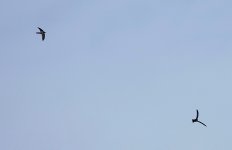 DSC07438 Himalayan Swiftlet @ San Tin.jpg1.2 MB · Views: 17
DSC07438 Himalayan Swiftlet @ San Tin.jpg1.2 MB · Views: 17 -
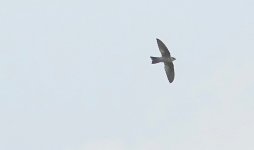 DSC07499 Himalayan Swiftlet @ San Tin.jpg234.1 KB · Views: 18
DSC07499 Himalayan Swiftlet @ San Tin.jpg234.1 KB · Views: 18 -
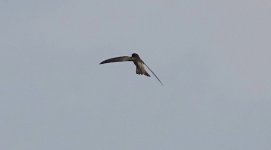 DSC07517 Himalayan Swiftlet @ San Tin.jpg401.2 KB · Views: 15
DSC07517 Himalayan Swiftlet @ San Tin.jpg401.2 KB · Views: 15 -
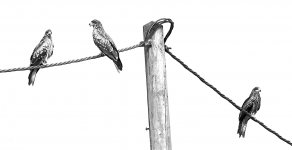 DSC07422 Black Kites @ San Tin.jpg210.2 KB · Views: 19
DSC07422 Black Kites @ San Tin.jpg210.2 KB · Views: 19 -
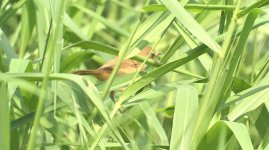 IMG_1339 Manchurian Reed Warbler @ San Tin.jpg298.1 KB · Views: 20
IMG_1339 Manchurian Reed Warbler @ San Tin.jpg298.1 KB · Views: 20
Last edited:
Owen Krout
Well-known member

Sounds like an enjoyable day, Mike. I think I may have missed on a lifer awhile back. I had one of my bust days with not really finding anything interesting except for several somethings making a buzzy call deep down in the 2 meter plus tall reeds. MRW are not usually found, or at least reported here, but your description of a buzzy call prompted me to check it out and it does sound like what I was hearing.
MKinHK
Mike Kilburn

A much cooler and, as a result, longer and more enjoyable visit to San Tin this morning. I made a decent start and was on-site shortly after 0730 and almost immediately picked up a surprise immature Gull-billed Tern as I entered the ponds. I was fully expecting to find Whiskered Terns, but this was an altogether large and more heavyset bird. My intention was to head straight for the spot where I'd seen the Manchurian Reed Warbler last weekend, but I got distracted by a bunch of Chinese Starlings in the big trees in the middle of the site. I was hoping the flock might be carrying a Daurian Starling, as happened around this time last year. No such luck, but the same tree did hold my first flycatcher of the autumn - an Asian Brown Flycatcher, and the first of three Red Turtle Doves graced the wires nearby.
Nor did I have any luck with the Manchurian Reed Warbler, but the same area held up to 25 Whiskered Terns feeding over an adjacent pond and over the course of the morning I enjoyed a fine suite of new migrants which included singles of Hair-crested Drongo and Black-winged Cuckooshrike in the same tree, an unexpected juvenile Black-naped Monarchin the sonneratia mangroves growing along one of the tidal drainage channels, the familiar winter sound of a tacking Dusky Warbler. Even better, the Black-winged Kite that was seen during the week drifted overhead, and spent an hour hunting in the area without ever giving me a chance of a shot. Further signs of passage included Oriental Reed Warblers increasing to ten and Black Drongos to five birds respectively.
A couple of each of the locally breeding Oriental Turtle Dove and White-cheeked Starling and four juvenile Yellow Bitterns added to the mix, and while wader numbers continue to float along at 8-10 species, today's highlight was three different Swintail Snipe flushing from the bunds. One Turnstone remained, providing an excuse to put up more shots from last weekend, and on my way out I was pleased to pick up two patch ticks in the form of a calling Pale-legged Leaf Warbler, and an escaped Chestnut Munia that looked stunning in its black hood.
Cheers
Mike
Nor did I have any luck with the Manchurian Reed Warbler, but the same area held up to 25 Whiskered Terns feeding over an adjacent pond and over the course of the morning I enjoyed a fine suite of new migrants which included singles of Hair-crested Drongo and Black-winged Cuckooshrike in the same tree, an unexpected juvenile Black-naped Monarchin the sonneratia mangroves growing along one of the tidal drainage channels, the familiar winter sound of a tacking Dusky Warbler. Even better, the Black-winged Kite that was seen during the week drifted overhead, and spent an hour hunting in the area without ever giving me a chance of a shot. Further signs of passage included Oriental Reed Warblers increasing to ten and Black Drongos to five birds respectively.
A couple of each of the locally breeding Oriental Turtle Dove and White-cheeked Starling and four juvenile Yellow Bitterns added to the mix, and while wader numbers continue to float along at 8-10 species, today's highlight was three different Swintail Snipe flushing from the bunds. One Turnstone remained, providing an excuse to put up more shots from last weekend, and on my way out I was pleased to pick up two patch ticks in the form of a calling Pale-legged Leaf Warbler, and an escaped Chestnut Munia that looked stunning in its black hood.
Cheers
Mike
Attachments
Last edited:
Users who are viewing this thread
Total: 2 (members: 0, guests: 2)




